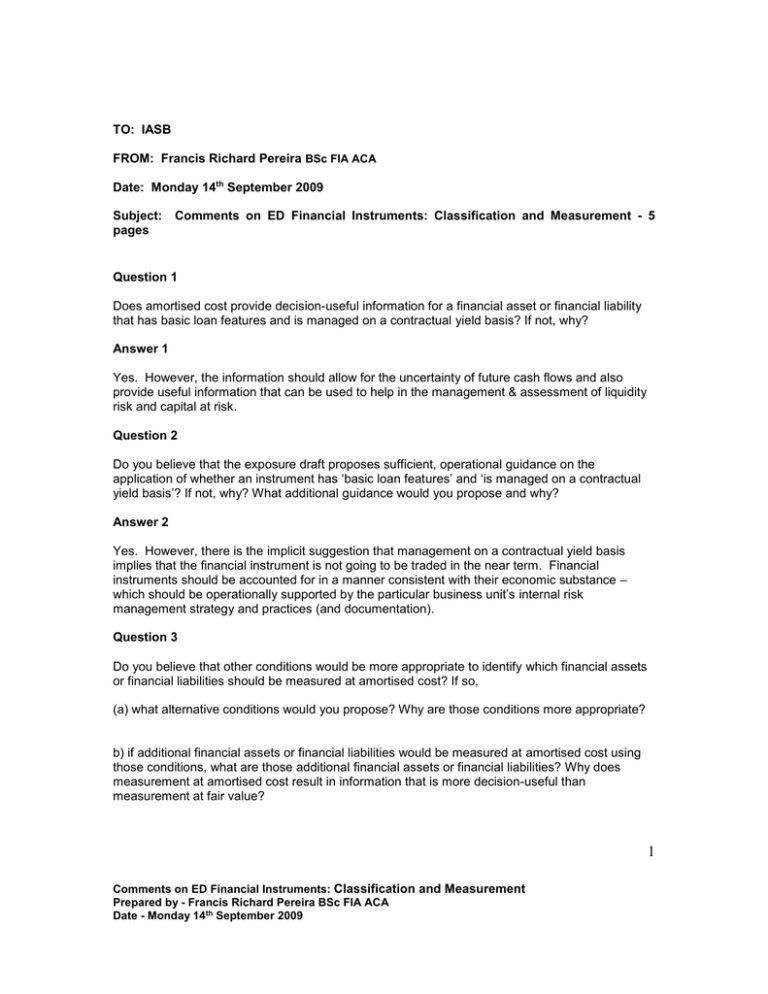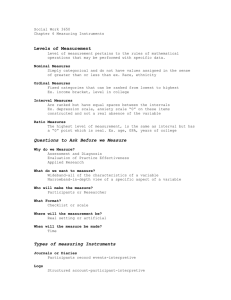CL128.doc
advertisement

TO: IASB FROM: Francis Richard Pereira BSc FIA ACA Date: Monday 14th September 2009 Subject: pages Comments on ED Financial Instruments: Classification and Measurement - 5 Question 1 Does amortised cost provide decision-useful information for a financial asset or financial liability that has basic loan features and is managed on a contractual yield basis? If not, why? Answer 1 Yes. However, the information should allow for the uncertainty of future cash flows and also provide useful information that can be used to help in the management & assessment of liquidity risk and capital at risk. Question 2 Do you believe that the exposure draft proposes sufficient, operational guidance on the application of whether an instrument has ‘basic loan features’ and ‘is managed on a contractual yield basis’? If not, why? What additional guidance would you propose and why? Answer 2 Yes. However, there is the implicit suggestion that management on a contractual yield basis implies that the financial instrument is not going to be traded in the near term. Financial instruments should be accounted for in a manner consistent with their economic substance – which should be operationally supported by the particular business unit’s internal risk management strategy and practices (and documentation). Question 3 Do you believe that other conditions would be more appropriate to identify which financial assets or financial liabilities should be measured at amortised cost? If so, (a) what alternative conditions would you propose? Why are those conditions more appropriate? b) if additional financial assets or financial liabilities would be measured at amortised cost using those conditions, what are those additional financial assets or financial liabilities? Why does measurement at amortised cost result in information that is more decision-useful than measurement at fair value? 1 Comments on ED Financial Instruments: Classification and Measurement Prepared by - Francis Richard Pereira BSc FIA ACA Date - Monday 14th September 2009 (c) if financial assets or financial liabilities that the exposure draft would measure at amortised cost do not meet your proposed conditions, do you think that those financial assets or financial liabilities should be measured at fair value? If not, what measurement attribute is appropriate and why? Answer 3 a) See Answer 2 b) No comment a) No comment Question 4 (a) Do you agree that the embedded derivative requirements for a hybrid contract with a financial host should be eliminated? If not, please describe any alternative proposal and explain how it simplifies the accounting requirements and how it would improve the decision-usefulness of information about hybrid contracts. (b) Do you agree with the proposed application of the proposed classification approach to contractually subordinated interests (ie tranches)? If not, what approach would you propose for such contractually subordinated interests? How is that approach consistent with the proposed classification approach? How would that approach simplify the accounting requirements and improve the decision usefulness of information about contractually subordinated interests? Answer 4 a) Yes b) Yes. However, subordinated tranches that legally carry contractual rights (even though subordinated) – can in practice still be instruments that are managed on a contractual yield basis. This is one area where the recent BIS comments should be considered. Question 5 Do you agree that entities should continue to be permitted to designate any financial asset or financial liability at fair value through profit or loss if such designation eliminates or significantly reduces an accounting mismatch? If not, why? Answer 5 Yes. I believe this is useful and more so if it allows for more consistency between the actual cash flow of the business and what is reported in the profit or loss. 2 Comments on ED Financial Instruments: Classification and Measurement Prepared by - Francis Richard Pereira BSc FIA ACA Date - Monday 14th September 2009 Question 6 Should the fair value option be allowed under any other circumstances? If so, under what other circumstances should it be allowed and why? Answer 6 No comment Question 7 Do you agree that reclassification should be prohibited? If not, in what circumstances do you believe reclassification is appropriate and why do such reclassifications provide understandable and useful information to users of financial statements? How would you account for such reclassifications, and why? Answer 7 Yes, most of the time. However, if the business unit has changed its risk management policy to either a more active or passive basis then it may be possible that reclassification should change. The worry is that this flexibility may be subject to abuse – so I think any change in accounting treatment should be accompanied by a disclosed explanation to debt and equity stakeholders on why the change may help shareholders see greater consistency between what is reported in the cash flow statement and the profit or loss and the management of liquidity and capital. Question 8 Do you believe that more decision-useful information about investments in equity instruments (and derivatives on those equity instruments) results if all such investments are measured at fair value? If not, why? Answer 8 Yes. However, it will depend on how the equity position is being risk managed. For example, if a position is held as a long term strategic investment than it may be more appropriate if it is measured at fair value but not through the profit or loss account. Short term positions held for trading may be better captured at fair value through the profit or loss account. Question 9 Are there circumstances in which the benefits of improved decision-usefulness do not outweigh the costs of providing this information? What are those circumstances and why? In such circumstances, what impairment test would you require and why? Answer 9 No comment 3 Comments on ED Financial Instruments: Classification and Measurement Prepared by - Francis Richard Pereira BSc FIA ACA Date - Monday 14th September 2009 Question 10 Do you believe that presenting fair value changes (and dividends) for particular investments in equity instruments in other comprehensive income would improve financial reporting? If not, why? Answer 10 Yes. However, it may be possible to allow for dividends to go through the profit or loss account – this will show more consistency to the cash flow statement and also may be in line with the operational use of the cash, especially for long term strategic equity positions. Question 11 Do you agree that an entity should be permitted to present in other comprehensive income changes in the fair value (and dividends) of any investment in equity instruments (other than those that are held for trading), only if it elects to do so at initial recognition? If not, (a) how do you propose to identify those investments for which presentation in other comprehensive income is appropriate? Why? (b) should entities present changes in fair value in other comprehensive income only in the periods in which the investments in equity instruments meet the proposed identification principle in (a)? Why? Answer 11 Yes However, if a business rationale changes, for example from a long term position to short term position that becomes managed on a fair value basis and with a relatively shorter term outlook than previously - than the accounting treatment should reflect this management or business intention. Broadly, the impact on the profit or loss may then be more consistent with the anticipated impact on cash flow. Question 12 Do you agree with the additional disclosure requirements proposed for entities that apply the proposed IFRS before its mandated effective date? If not, what would you propose instead and why? Answer 12 Yes Question 13 Do you agree with applying the proposals retrospectively and the related proposed transition guidance? If not, why? What transition guidance would you propose instead and why? Answer 13 Yes 4 Comments on ED Financial Instruments: Classification and Measurement Prepared by - Francis Richard Pereira BSc FIA ACA Date - Monday 14th September 2009 Question 14 Do you believe that this alternative approach provides more decision-useful information than measuring those financial assets at amortised cost, specifically: (a) in the statement of financial position? (b) in the statement of comprehensive income? If so, why? Answer 14 No comment Question 15 Do you believe that either of the possible variants of the alternative approach provides more decision-useful information than the alternative approach and the approach proposed in the exposure draft? If so, which variant and why? Answer 15 No comment 5 Comments on ED Financial Instruments: Classification and Measurement Prepared by - Francis Richard Pereira BSc FIA ACA Date - Monday 14th September 2009




